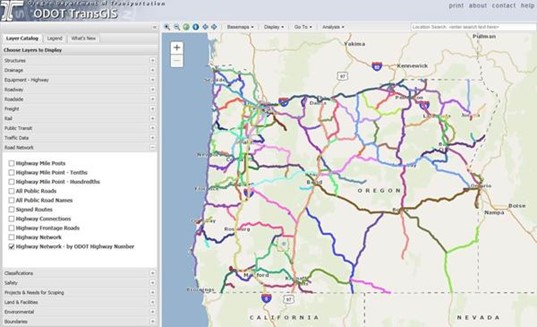The Oregon DOT Implements Two Programs to Create Feasible Asset Management for Oregon’s Roadway Infrastructure.
Statewide, Oregon, United States
Asset Management in Oregon Roadway Safety Data and Analysis
Summary Information
To overcome the challenge of disparate asset data and data/process duplication, the Oregon Department of Transportation (ODOT) implemented two new programs to manage their roadway assets. The first program, TransInfo, is a statewide asset management system that provides ODOT asset management staff with the most up-to-date statistics on assets and other features on the State highway system. The second program is the Features, Attributes, and Conditions – Statewide Transportation Improvement Program (FACS-STIP) Tool, which is a web-based program that provides information on an asset’s location, attributes, and condition. This tool uses the ArcGIS Server to create maps for assets and can also generate reports in a spreadsheet format. The goal of the two programs is to deploy a statewide inventory for all roadway assets, establish methods for data validation, and make the best use of the integrated data for network screening.
Methodology
ODOT created TransInfo to reconcile and connect disparate asset data, maintain a spatial representation of all information, and integrate all network assets and asset information systems. The program allows the agency to model and manage data in an efficient manner for transactional data collection and maintenance. Under Transinfo, it is easier to generate accurate reports and support Governmental Accounting Standards Board Standard 34 for asset reporting. All information and data are easily accessible to ODOT and all other consumers.

The FACS-STIP Tool is designed for external users to have access to statewide asset management data and spatial mapping functions. FACS-STIP serves as the single location for users to access asset information stored at ODOT. The solution is a GIS implementation with a map-based user interface. Analysis and data management tools appear in a simple, one-menu user interface design.
Accessing all asset data through a single, uniform asset management system enabled the following benefits:
- The new statewide asset management system is expected to deliver approximately $3.4 million in tangible benefits, as well as many intangible ones. For example, the system has streamlined data entry and reporting, enhanced data accuracy and available detail, reduced risk of errors, cut training time and improved safety.
- Reduced time to enter construction-planning information by 15 percent and labor costs related to data collection, entry, and maintenance by 10 percent.
- Realized a 66 percent increase in overall efficiency compared to when the other systems were used.
- Using the mobile collection portion of the FACS-STIP Tool allows for maintenance crews to collect data electronically using mobile devices, eliminating the use of hard copies.
